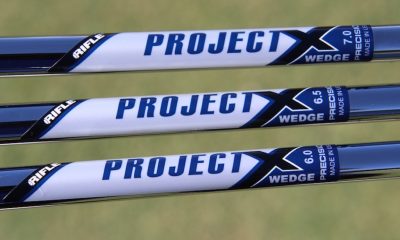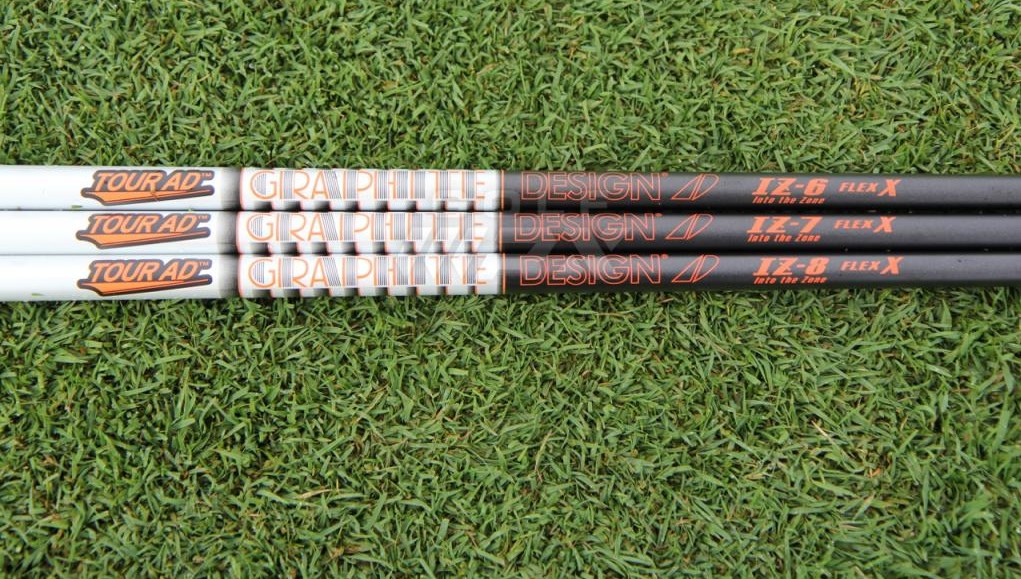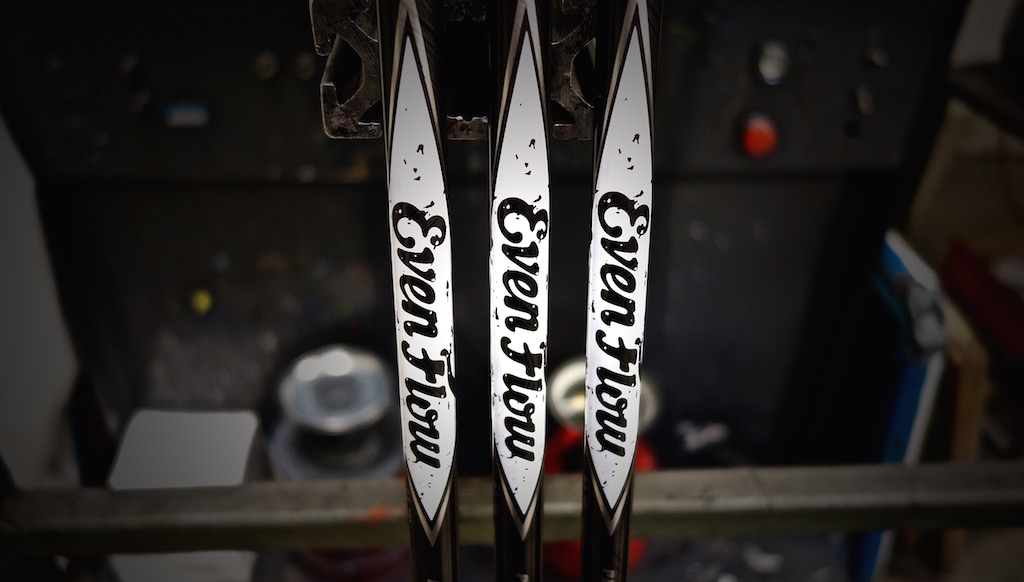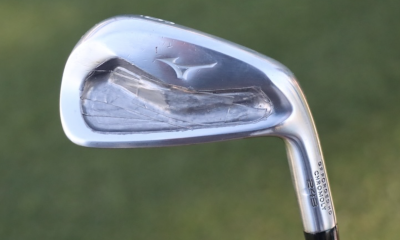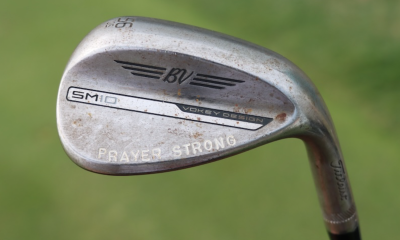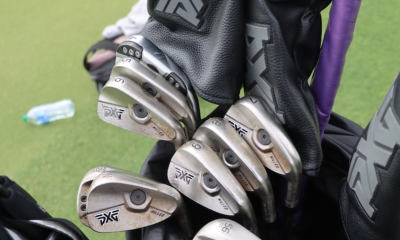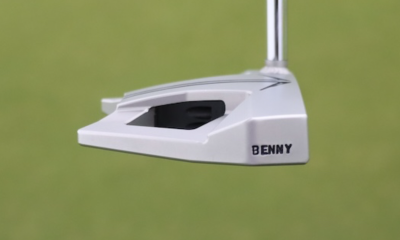Opinion & Analysis
Part 3: Facts about shafts, and what they do
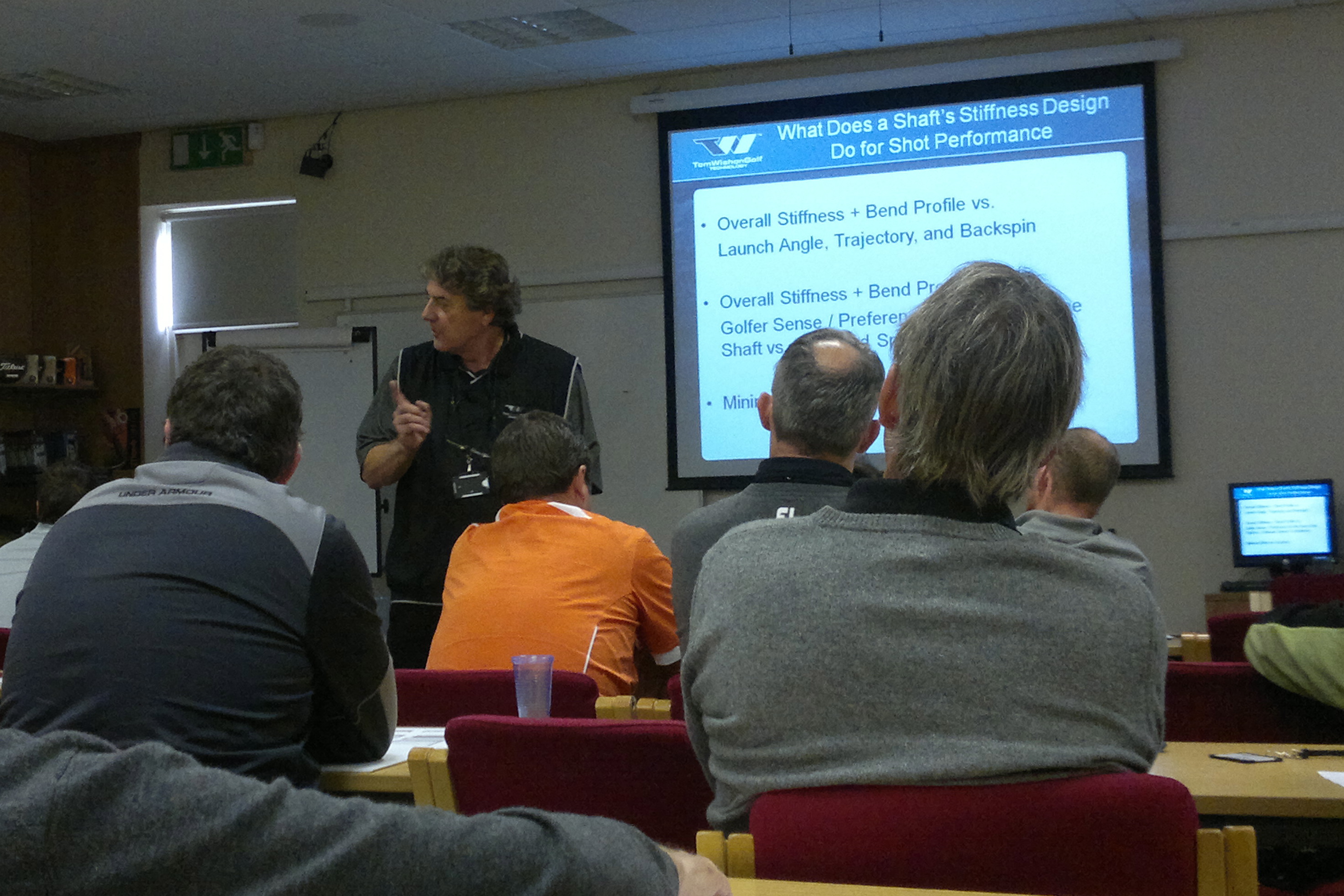
There is no question the shaft is the least understood of all the components of a golf club.
The first reason is because most golfers simply do not know what the shaft can and cannot do to influence the outcome of a shot. Second, many golfers think that the shaft does what it does for every golfer who uses that shaft. It is very common for a golfer to switch shafts, see a visible change in ball flight, and attribute all of the shot change they see to the shaft. In reality, there are other fitting parameters in the club that underwent a significant change when the new shaft was installed, which may or may not be the reason for the change in ball flight.
In Part 1 and Part 2 of my series on shafts, you have learned how it is possible to measure and express a shaft’s flex and bend profile design in quantitative terms. The graphs and stiffness measurement data take flex and bend profile comparison and selection to the same level of quantitative measurement as all the other specs of the golf club which are measured in degrees, grams and inches.
But in the end, even with the ability to empirically compare shaft flex and bend profile, there are still questions:
- How does the shaft contribute to ball flight?
- For who does it contribute?
- How much does it contribute?
- How does it actually contribute?
I’ve spent decades in my career doing this study and I strongly believe that we do know the answers to these often confusing questions about the performance of the shaft.
The shaft can have an effect on launch angle, trajectory and spin rate. How much of an effect the shaft has on these shot parameters depends on the lateness of a golfer’s release, their clubhead speed and how aggressive their downswing tempo is. In addition, how much the shaft can change launch angle, trajectory and spin for golfers who do have the swing characteristics to make the shaft perform depends completely on the overall stiffness and bend profile of the new shaft versus the golfer’s previous shaft.
For those of you who have read some of my articles and posts on shafts, you have heard this part before. The shaft’s effect on launch angle, trajectory and backspin only become visible as the golfer’s release occurs later and later in the downswing. In addition, the shaft’s effect on trajectory and spin progresses more and more as the golfer’s clubhead speed and downswing aggressiveness/force increases.
Golfers who unhinge the wrist cock early to midway in the downswing do NOT experience a difference in launch angle, trajectory or backspin from shafts of different flex and different bend profile. They do experience a difference in how solid or boardy the impact with the ball is. But as the release gets to midway on the downswing, and progressively a little later and later beyond midway in the downswing, the shaft begins to have a little more and more effect on launch angle, trajectory and spin.
The reason the shaft can have an effect on launch angle, trajectory and spin for later release players is because of the way the timing of the bending of the shaft can affect the dynamic loft of the clubhead at impact. When the golfer begins to unhinge their wrist cock angle on the downswing, the golfer’s hands/arms begin to slow down while the club accelerates.
Yes, for EVERY golfer, once he or she unhinges the wrist cock angle, their arms slow down. Because the hands are holding the club while the arms are slowing down, the acceleration of the club begins to push the shaft against the resistance of the slowing arms/hands into a forward bend position.
The later the golfer’s release, the more the forward bending of the shaft can arrive at impact in that forward bend position. For a midway release, the shaft only has a slight amount of forward bend by the time the clubhead gets to the ball. For an early to midway release, the forward bending of the shaft happens too soon, so that by the time the clubhead gets to the ball, the shaft has rebounded back to straight, thus not changing the dynamic loft of the clubhead at impact.
It is important to understand that two golfers can have the same launch angle, but have totally different trajectories and backspin amounts from each other. If two golfers with different clubhead speeds have the same swing path, same angle of attack and same hand position at impact, the launch angle will be the same but the trajectory and spin rates will differ. The higher the clubhead speed of the golfer, the higher the trajectory and spin will be for any given launch angle.
How much can the shaft affect the launch angle and spin rate for those golfers who do have a later to very late release?
Two things control this. First, when a golfer uses a different shaft than he has been playing, the only way the shaft can change the launch angle and spin is if the new shaft is different in its overall stiffness design than the old shaft. Second, how much the shaft can affect launch angle and spin also depends on how flexible or stiff the shaft is in relation to the golfer’s clubhead speed, transition and tempo force and point of release.
First, I see TONS of posts and questions in the GolfWRX forums that say something like:
“I need a recommendation for a good low-launching (or high-launching), low-spin shaft.”
Such a question is asked as if the golfer thinks that a shaft will demonstrate the same effect on launch angle and spin for every golfer who uses it.
While the shaft companies like to say their shafts are designed to have certain launch and spin characteristics, the truth is that a shaft can only offer a low or higher launch/spin if it is stiffer or more flexible THAN WHAT THE GOLFER USED BEFORE.
In other words, what is a low-launch and low-spin shaft for Golfer A can be a high-launch and high-spin shaft for Golfer B, and vice versa. FOR THE SAME SHAFT, the golfer with the higher clubhead speed, later release and more upward angle of attack is going to hit shots with a higher launch, higher trajectory and higher spin than will the golfer with a lower clubhead speed, earlier release and more downward angle of attack.
So, for golfers who are looking for a low-launch, low-spinning shaft, the only way you can find that is to:
- Know precisely what the overall stiffness and bend profile stiffness design is of the shaft you now play, and…
- Know the overall stiffness and bend profile stiffness design of all other shafts so you can pick one that is stiffer overall and/or has a more stiff tip section design.
Shafts are dumb animals. They only do what their owner’s swing forces them to do.
Second, if a late-release golfer were to play with a soft L-Flex shaft one day and a stiff X-Flex the next, without question the difference in launch angle, trajectory and spin would be very significant. But common sense says this isn’t going to happen because each golfer should play a shaft that has its overall stiffness and bend profile properly matched to the golfer’s unique combination of clubhead speed, transition/tempo force and point of wrist cock release.
Sure, some of us prefer to play a shaft that feels stiffer. Some of us like to play a shaft that feels a little more flexible. If a golfer has a preferred sense of bending feel for a shaft, without question, regardless of their clubhead speed, transition/tempo and point of release, their best shaft has to satisfy that bending feel preference or their swing tempo/timing/rhythm/release gets screwed up and becomes inconsistent.
But within shafts that reasonably fit a golfer’s clubhead speed, transition/tempo and point of release, typically the maximum difference seen in launch angle from different shaft options is in the area of 2.5-to-3 degrees. As far as spin difference, that depends on the clubhead speed of the golfer. A shaft that launches the ball 2-degrees higher for a golfer with an 80 mph clubhead speed would typically increase spin by 350-to-400 rpm, while a shaft that launches the ball 2-degrees higher for a golfer with a 100 mph clubhead speed would typically increase spin by 500-to-600 rpm – that is, of course, given the same clubhead and same other assembly specs of the club.
So the bottom line is this: shafts can bring about changes in launch angle, trajectory and spin, but only for golfers with a later-to-late release, and only to the extent that their overall stiffness and bend profile are different from the shaft the golfer previously played.
If the golfer has developed a preferred sense of bending feel for the shaft, playing a shaft that satisfies that preferred bending feel will enable the golfer to achieve their highest clubhead speed. However, for such a golfer, playing a shaft that does NOT perfectly match their preferred bending feel will bring about a lower clubhead speed, worse accuracy and more off-center hits.
Here’s a statement about shafts that I have heard a few times in my career:
“Different shaft designs can be designed with a higher tip velocity to allow the golfer to achieve a higher clubhead speed.”
That’s not correct. As I said before, shafts are dumb animals. They ONLY do what the swing characteristics of their owners cause them to do. Whenever a golfer uses a shaft that has its weight, overall stiffness and bend profile well matched to the golfer’s clubhead speed, transition/tempo, point of release AND preference for bending feel, that’s when the golfer will achieve their highest clubhead speed. But this is only if the specs of length, loft, face angle, total weight, swing weight, and grip size are correctly fit to the golfer as well.
Give that same shaft to a different golfer with the same clubhead speed but a different combination of transition/tempo, point of release and preference for bending feel and that same shaft will result in a lower clubhead speed with far worse performance for that golfer BECAUSE THE SHAFT DOES NOT FIT THE SWING CHARACTERISTICS OF THE OTHER GOLFER.
A shaft can only exhibit a high level of “tip velocity” for the golfers whose clubhead speed, transition/tempo, point of release AND preference for bending feel is perfectly matched to the weight, overall stiffness and bend profile of the shaft.
Conclusion
The flex (overall stiffness) and bend profile (distribution of stiffness over the length of the shaft) are without question an important performance element of the golf club – but only to golfers whose point of release is later in the downswing. In addition, the flex and bend profile of the shaft becomes more of a performance element in the shot as the golfer’s clubhead speed gets higher and their transition and tempo gets more aggressive.
So for golfers with an early-to-midway release with a slower swing speed and with a less forceful and aggressive transition and tempo, the shaft’s flex and bend profile will not affect launch angle, trajectory and backspin and become chiefly a contributor to the impact feel of the shot coming off the clubhead.
As always, the very best way to be fit to the best shaft for your swing and for your shot shape requirements is to find a good clubmaker. There are clubmakers out there who really live, eat and breathe the quantitative and swing analysis approach to shaft fitting. If you want the best fitting, see one of these clubmakers and you will be well ahead for doing so.
To find a good Clubmaker in your area, consult any of these following sources:
- The AGCP (Association of Golf Clubfitting Professionals)
- The ICG (International Clubmakers’ Guild)
- The TWGT Clubmaker Locator
Related
- Part 1 — Taking the guesswork out of selecting shafts
- Part 2 — Taking shaft fitting from guessing to specifics
- Part 3 — Facts about shafts, and what they do
- LIKE86
- LEGIT9
- WOW8
- LOL1
- IDHT2
- FLOP1
- OB1
- SHANK2
Instruction
The Wedge Guy: The easiest-to-learn golf basic

My golf learning began with this simple fact – if you don’t have a fundamentally sound hold on the golf club, it is practically impossible for your body to execute a fundamentally sound golf swing. I’m still a big believer that the golf swing is much easier to execute if you begin with the proper hold on the club.
As you might imagine, I come into contact with hundreds of golfers of all skill levels. And it is very rare to see a good player with a bad hold on the golf club. There are some exceptions, for sure, but they are very few and very far between, and they typically have beat so many balls with their poor grip that they’ve found a way to work around it.
The reality of biophysics is that the body moves only in certain ways – and the particulars of the way you hold the golf club can totally prevent a sound swing motion that allows the club to release properly through the impact zone. The wonderful thing is that anyone can learn how to put a fundamentally sound hold on the golf club, and you can practice it anywhere your hands are not otherwise engaged, like watching TV or just sitting and relaxing.
Whether you prefer an overlap, interlock or full-finger (not baseball!) grip on the club, the same fundamentals apply. Here are the major grip faults I see most often, in the order of the frequency:
Mis-aligned hands
By this I mean that the palms of the two hands are not parallel to each other. Too many golfers have a weak left hand and strong right, or vice versa. The easiest way to learn how to hold the club with your palms aligned properly is to grip a plain wooden ruler or yardstick. It forces the hands to align properly and shows you how that feels. If you grip and re-grip a yardstick several times, then grip a club, you’ll see that the learning curve is almost immediate.
The position of the grip in the upper/left hand
I also observe many golfers who have the butt of the grip too far into the heel pad of the upper hand (the left hand for right-handed players). It’s amazing how much easier it is to release the club through the ball if even 1/4-1/2″ of the butt is beyond the left heel pad. Try this yourself to see what I mean. Swing the club freely with just your left hand and notice the difference in its release from when you hold it at the end of the grip, versus gripping down even a half inch.
To help you really understand how this works, go to the range and hit shots with your five-iron gripped down a full inch to make the club the same length as your seven-iron. You will probably see an amazing shot shape difference, and likely not see as much distance loss as you would expect.
Too much lower (right) hand on the club
It seems like almost all golfers of 8-10 handicap or higher have the club too far into the palm of the lower hand, because that feels “good” if you are trying to control the path of the clubhead to the ball. But the golf swing is not an effort to hit at the ball – it is a swing of the club. The proper hold on the club has the grip underneath the pad at the base of the fingers. This will likely feel “weak” to you — like you cannot control the club like that. EXACTLY. You should not be trying to control the club with your lower/master hand.
Gripping too tightly
Nearly all golfers hold the club too tightly, which tenses up the forearms and prevents a proper release of the club through impact. In order for the club to move back and through properly, you must feel that the club is controlled by the last three fingers of the upper hand, and the middle two fingers of the lower hand. If you engage your thumbs and forefingers in “holding” the club, the result will almost always be a grip that is too tight. Try this for yourself. Hold the club in your upper hand only, and squeeze firmly with just the last three fingers, with the forefinger and thumb off the club entirely. You have good control, but your forearms are not tense. Then begin to squeeze down with your thumb and forefinger and observe the tensing of the entire forearm. This is the way we are made, so the key to preventing tenseness in the arms is to hold the club very lightly with the “pinchers” — the thumbs and forefingers.
So, those are what I believe are the four fundamentals of a good grip. Anyone can learn them in their home or office very quickly. There is no easier way to improve your ball striking consistency and add distance than giving more attention to the way you hold the golf club.
More from the Wedge Guy
- The Wedge Guy: Golf mastery begins with your wedge game
- The Wedge Guy: Why golf is 20 times harder than brain surgery
- The Wedge Guy: Musings on the golf ball rollback
- LIKE80
- LEGIT13
- WOW4
- LOL1
- IDHT0
- FLOP4
- OB1
- SHANK8
19th Hole
Vincenzi’s 2024 Texas Children’s Houston Open betting preview

As the Florida swing comes to an end, the PGA Tour makes its way to Houston to play the Texas Children’s Houston Open at Memorial Park Golf Course.
This will be the fourth year that Memorial Park Golf Course will serve as the tournament host. The event did not take place in 2023, but the course hosted the event in 2020, 2021 and 2022.
Memorial Park is a par-70 layout measuring 7,432 yards and features Bermudagrass greens. Historically, the main defense for the course has been thick rough along the fairways and tightly mown runoff areas around the greens. Memorial Park has a unique setup that features three Par 5’s and five Par 3’s.
The field will consist of 132 players, with the top 65 and ties making the cut. There are some big names making the trip to Houston, including Scottie Scheffler, Wyndham Clark, Tony Finau, Will Zalatoris and Sahith Theegala.
Past Winners at Memorial Park
- 2022: Tony Finau (-16)
- 2021: Jason Kokrak (-10)
- 2020: Carlos Ortiz (-13)
In this article and going forward, I’ll be using the Rabbit Hole by Betsperts Golf data engine to develop my custom model. If you want to build your own model or check out all of the detailed stats, you can sign up using promo code: MATTVIN for 25% off any subscription package (yearly is best value).
Key Stats For Memorial Park
Let’s take a look at several metrics for Memorial Park to determine which golfers boast top marks in each category over their last 24 rounds:
Strokes Gained: Approach
Memorial Park is a pretty tough golf course. Golfers are penalized for missing greens and face some difficult up and downs to save par. Approach will be key.
Total Strokes Gained: Approach per round in past 24 rounds:
- Tom Hoge (+1.30)
- Scottie Scheffler (+1.26)
- Keith Mitchell (+0.97)
- Tony Finau (+0.92)
- Jake Knapp (+0.84)
Strokes Gained: Off the Tee
Memorial Park is a long golf course with rough that can be penal. Therefore, a combination of distance and accuracy is the best metric.
Total Strokes Gained: Off the Tee per round in past 24 rounds:
- Scottie Scheffler (+0.94)
- Kevin Dougherty (+0.93)
- Cameron Champ (+0.86)
- Rafael Campos (+0.84)
- Si Woo Kim (+0.70)
Strokes Gained Putting: Bermudagrass + Fast
The Bermudagrass greens played fairly fast the past few years in Houston. Jason Kokrak gained 8.7 strokes putting on his way to victory in 2021 and Tony Finau gained in 7.8 in 2022.
Total Strokes Gained Putting (Bermudagrass) per round past 24 rounds (min. 8 rounds):
- Adam Svensson (+1.27)
- Harry Hall (+1.01)
- Martin Trainer (+0.94)
- Taylor Montgomery (+0.88)
- S.H. Kim (+0.86)
Strokes Gained: Around the Green
With firm and undulating putting surfaces, holding the green on approach shots may prove to be a challenge. Memorial Park has many tightly mowed runoff areas, so golfers will have challenging up-and-down’s around the greens. Carlos Ortiz gained 5.7 strokes around the green on the way to victory in 2020.
Total Strokes Gained: Around the Green per round in past 24 rounds:
- Mackenzie Hughes (+0.76)
- S.H. Kim (+0.68)
- Scottie Scheffler (+0.64)
- Jorge Campillo (+0.62)
- Jason Day (+0.60)
Strokes Gained: Long and Difficult
Memorial Park is a long and difficult golf course. This statistic will incorporate players who’ve had success on these types of tracks in the past.
Total Strokes Gained: Long and Difficult in past 24 rounds:
- Scottie Scheffler (+2.45)
- Ben Griffin (+1.75)
- Will Zalatoris (+1.73)
- Ben Taylor (+1.53)
- Tony Finau (+1.42)
Course History
Here are the players who have performed the most consistently at Memorial Park.
Strokes Gained Total at Memorial Park past 12 rounds:
- Tyson Alexander (+3.65)
- Ben Taylor (+3.40)
- Tony Finau (+2.37)
- Joel Dahmen (+2.25)
- Patton Kizzire (+2.16)
Statistical Model
Below, I’ve reported overall model rankings using a combination of the five key statistical categories previously discussed.
These rankings are comprised of SG: App (24%) SG: OTT (24%); SG: Putting Bermudagrass/Fast (13%); SG: Long and Difficult (13%); SG: ARG (13%) and Course History (13%)
- Scottie Scheffler
- Wyndham Clark
- Tony Finau
- Joel Dahmen
- Stephan Jaeger
- Aaron Rai
- Sahith Theegala
- Keith Mitchell
- Jhonnatan Vegas
- Jason Day
- Kurt Kitayama
- Alex Noren
- Will Zalatoris
- Si Woo Kim
- Adam Long
2024 Texas Children’s Houston Open Picks
Will Zalatoris +2000 (Caesars)
Scottie Scheffler will undoubtedly be difficult to beat this week, so I’m starting my card with someone who I believe has the talent to beat him if he doesn’t have his best stuff.
Will Zalatoris missed the cut at the PLAYERS, but still managed to gain strokes on approach while doing so. In an unpredictable event with extreme variance, I don’t believe it would be wise to discount Zalatoris based on that performance. Prior to The PLAYERS, the 27-year-old finished T13, T2 and T4 in his previous three starts.
Zalatoris plays his best golf on long and difficult golf courses. In his past 24 rounds, he ranks 3rd in the category, but the eye test also tells a similar story. He’s contended at major championships and elevated events in the best of fields with tough scoring conditions. The Texas resident should be a perfect fit at Memorial Park Golf Club.
Alex Noren +4500 (FanDuel)
Alex Noren has been quietly playing some of his best golf of the last half decade this season. The 41-year-old is coming off back-to-back top-20 finishes in Florida including a T9 at The PLAYERS in his most recent start.
In his past 24 rounds, Noren ranks 21st in the field in Strokes Gained: Off the Tee, 30th in Strokes Gained: Around the Green, 25th in Strokes Gained: Total on long and difficult courses and 21st in Strokes Gained: Putting on fast Bermudagrass greens.
In addition to his strong recent play, the Swede also has played well at Memorial Park. In 2022, Noren finished T4 at the event, gaining 2.2 strokes off the tee and 7.0 strokes on approach for the week. In his two starts at the course, he’s gained an average of .6 strokes per round on the field, indicating he is comfortable on these greens.
Noren has been due for a win for what feels like an eternity, but Memorial Park may be the course that suits him well enough for him to finally get his elusive first PGA Tour victory.
Mackenzie Hughes +8000 (FanDuel)
Mackenzie Hughes found himself deep into contention at last week’s Valspar Championship before faltering late and finishing in a tie for 3rd place. While he would have loved to win the event, it’s hard to see the performance as anything other than an overwhelming positive sign for the Canadian.
Hughes has played great golf at Memorial Park in the past. He finished T7 in 2020, T29 in 2021 and T16 in 2022. The course fit seems to be quite strong for Hughes. He’s added distance off the tee in the past year or and ranks 8th in the field for apex height, which will be a key factor when hitting into Memorial Park’s elevated greens with steep run-off areas.
In his past 24 rounds, Hughes is the best player in the field in Strokes Gained: Around the Greens. The ability to scramble at this course will be extremely important. I believe Hughes can build off of his strong finish last week and contend once again to cement himself as a President’s Cup consideration.
Akshay Bhatia +8000 (FanDuel)
Akshay Bhatia played well last week at the Valspar and seemed to be in total control of his golf ball. He finished in a tie for 17th and shot an impressive -3 on a difficult Sunday. After struggling Thursday, Akshay shot 68-70-68 in his next three rounds.
Thus far, Bhatia has played better at easier courses, but his success at Copperhead may be due to his game maturing. The 22-year-old has enormous potential and the raw talent to be one of the best players in the world when he figures it all out.
Bhatia is a high upside play with superstar qualities and may just take the leap forward to the next stage of his career in the coming months.
Cameron Champ +12000 (FanDuel)
Cameron Champ is a player I often target in the outright betting market due to his “boom-or-bust” nature. It’s hard to think of a player in recent history with three PGA Tour wins who’s been as inconsistent as Champ has over the course of his career.
Despite the erratic play, Cam Champ simply knows how to win. He’s won in 2018, 2019 and 2021, so I feel he’s due for a win at some point this season. The former Texas A&M product should be comfortable in Texas and last week he showed us that his game is in a pretty decent spot.
Over his past 24 rounds, Champ ranks 3rd in Strokes Gained: Off the Tee and 30th in Strokes Gained: Total on long and difficult courses. Given his ability to spike at any given time, Memorial Park is a good golf course to target Champ on at triple digit odds.
Robert MacIntyre +12000 (FanDuel)
The challenge this week is finding players who can possibly beat Scottie Scheffler while also not dumping an enormous amount of money into an event that has a player at the top that looks extremely dangerous. Enter McIntyre, who’s another boom-or-bust type player who has the ceiling to compete with anyone when his game is clicking on all cylinders.
In his past 24 rounds, MacIntyre ranks 16th in the field in Strokes Gained: Off the Tee, 17th in Strokes Gained: Around the Green and 10th in Strokes Gained: Total on long and difficult courses.
MacIntyre’s PGA Tour season has gotten off to a slow start, but he finished T6 in Mexico, which is a course where players will hit driver on the majority of their tee shots, which is what we will see at Memorial Park. Texas can also get quite windy, which should suit MacIntyre. Last July, the Scot went toe to toe with Rory McIlroy at the Scottish Open before a narrow defeat. It would take a similar heroic effort to compete with Scheffler this year in Houston.
Ryan Moore +15000 (FanDuel)
Ryan Moore’s iron play has been absolutely unconscious over his past few starts. At The PLAYERS Championship in a loaded field, he gained 6.1 strokes on approach and last week at Copperhead, he gained 9.0 strokes on approach.
It’s been a rough handful of years on Tour for the 41-year-old, but he is still a five-time winner on the PGA Tour who’s young enough for a career resurgence. Moore has chronic deterioration in a costovertebral joint that connects the rib to the spine, but has been getting more consistent of late, which is hopefully a sign that he is getting healthy.
Veterans have been contending in 2024 and I believe taking a flier on a proven Tour play who’s shown signs of life is a wise move at Memorial Park.
- LIKE15
- LEGIT1
- WOW1
- LOL0
- IDHT0
- FLOP0
- OB0
- SHANK2
Opinion & Analysis
Ryan: Why the race to get better at golf might be doing more harm than good

B.F. Skinner was one of the most important psychologists of the 20th century, developing the foundation of the development of reinforcement, and in doing so, creating the concept of behaviorism. In simple terms, this means that we are conditioned by our habits. In practical terms, it explains the divide between the few and far between elite instructors and college coaches.
To understand the application, let’s quickly review one of B.F. Skinner’s most important experiments; superstitions in the formation of behavior by pigeons. In this experiment, food was dispensed to pigeons at random intervals. Soon, according to Skinner, the pigeons began to associate whatever action they were doing at the time of the food being dispensed. According to Skinner, this conditioned that response and soon, they simply haphazardly repeated the action, failing to distinguish between cause and correlation (and in the meantime, looking really funny!).
Now, this is simply the best way to describe the actions of most every women’s college golf coach and too many instructors in America. They see something work, get positive feedback and then become conditioned to give the feedback, more and more, regardless of if it works (this is also why tips from your buddies never work!).
Go to a college event, particularly a women’s one, and you will see coaches running all over the place. Like the pigeons in the experiment, they have been conditioned into a codependent relationship with their players in which they believe their words and actions, can transform a round of golf. It is simply hilarious while being equally perturbing
In junior golf, it’s everywhere. Junior golf academies make a living selling parents that a hysterical coach and over-coaching are essential ingredients in your child’s success.
Let’s be clear, no one of any intellect has any real interest in golf — because it’s not that interesting. The people left, including most coaches and instructors, carve out a small fiefdom, usually on the corner of the range, where they use the illusion of competency to pray on people. In simple terms, they baffle people with the bullshit of pseudo-science that they can make you better, after just one more lesson.
The reality is that life is an impromptu game. The world of golf, business, and school have a message that the goal is being right. This, of course, is bad advice, being right in your own mind is easy, trying to push your ideas on others is hard. As a result, it is not surprising that the divorce rate among golf professionals and their instructors is 100 percent. The transfer rate among college players continues to soar, and too many courses have a guy peddling nefarious science to good people. In fact, we do at my course!
The question is, what impact does all this have on college-age and younger kids? At this point, we honestly don’t know. However, I am going to go out on a limb and say it isn’t good.
Soren Kierkegaard once quipped “I saw it for what it is, and I laughed.” The actions of most coaches and instructors in America are laughable. The problem is that I am not laughing because they are doing damage to kids, as well as driving good people away from this game.
The fact is that golfers don’t need more tips, secrets, or lessons. They need to be presented with a better understanding of the key elements of golf. With this understanding, they can then start to frame which information makes sense and what doesn’t. This will emancipate them and allow them to take charge of their own development.
- LIKE14
- LEGIT4
- WOW1
- LOL2
- IDHT0
- FLOP1
- OB0
- SHANK11
-

 19th Hole1 week ago
19th Hole1 week agoJohn Daly stuns fans into silence with brutal opening tee shot on PGA Tour Champions
-

 19th Hole2 days ago
19th Hole2 days agoThings got heated at the Houston Open between Tony Finau and Alejandro Tosti. Here’s why
-

 19th Hole2 weeks ago
19th Hole2 weeks ago2-time major champ announces shock retirement from the sport at age of 33
-

 19th Hole1 week ago
19th Hole1 week agoCharlie Woods finds it tough going on American Junior Golf Association debut
-

 19th Hole2 weeks ago
19th Hole2 weeks agoEdoardo Molinari reveals the latest PGA Tour golfer to turn down ‘good offer’ from LIV Golf
-

 Equipment3 weeks ago
Equipment3 weeks agoBest driver 2024: The best driver for you, as recommend by expert club fitters
-

 19th Hole2 weeks ago
19th Hole2 weeks agoScottie Scheffler had an interesting response when asked how he ‘quiets the noise’ following Players victory
-

 19th Hole2 weeks ago
19th Hole2 weeks agoJon Rahm dealt fresh blow to hopes of qualifying for 2025 Ryder Cup










